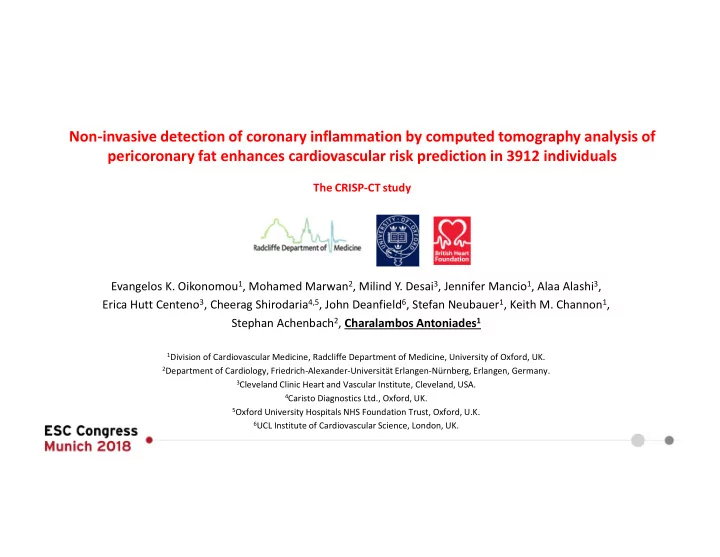

Non-invasive detection of coronary inflammation by computed tomography analysis of pericoronary fat enhances cardiovascular risk prediction in 3912 individuals The CRISP-CT study Evangelos K. Oikonomou 1 , Mohamed Marwan 2 , Milind Y. Desai 3 , Jennifer Mancio 1 , Alaa Alashi 3 , Erica Hutt Centeno 3 , Cheerag Shirodaria 4,5 , John Deanfield 6 , Stefan Neubauer 1 , Keith M. Channon 1 , Stephan Achenbach 2 , Charalambos Antoniades 1 1 Division of Cardiovascular Medicine, Radcliffe Department of Medicine, University of Oxford, UK. 2 Department of Cardiology, Friedrich-Alexander-Universität Erlangen-Nürnberg, Erlangen, Germany. 3 Cleveland Clinic Heart and Vascular Institute, Cleveland, USA. 4 Caristo Diagnostics Ltd., Oxford, UK. 5 Oxford University Hospitals NHS Foundation Trust, Oxford, U.K. 6 UCL Institute of Cardiovascular Science, London, UK.
Residual cardiovascular risk: the unmet need Normal Narrowed Blocked Artery Artery Artery INFLAMMATION Symptoms Time Fishbein et al. Circulation. 1996;94:2662-2666
Perivascular Fat Attenuation Index (FAI): Technology detecting coronary inflammation on CCTA “Healthy,” inflamed artery Healthy, non-inflamed artery ↓ Adipogenesis ↑Lipolysis ↑Oedema High FAI Low FAI Water Fat Water Fat Heart attack 3y later Healthy Antonopoulos A et al. Science Translational Medicine 2017
Can FAI predict cardiovascular risk?
The CRISP-CT study S Achenbach M Desai Oikonomou E et al; Lancet 2018 (in press)
FAI has prognostic value in predicting cardiac death Oikonomou E et al; Lancet 2018 (in press)
FAI has prognostic value in predicting cardiac death Oikonomou E et al; Lancet 2018 (in press)
FAI predicts non-fatal myocardial infarction Oikonomou E et al; Lancet 2018 (in press)
FAI improves prediction of cardiac death over and above current state-of-the-art Model 1 : age, sex, hypertension, hypercholesterolaemia, diabetes mellitus, smoker status, epicardial fat volume, modified Duke CAD index and number of high-risk plaque features on CCTA. Model 2 : Model 1 + FAI Areas under the curve: Derivation: 0·913 (95% CI 0·867–0·958) to 0·962 (0·940–0·983), P=0.0054 Validation: 0·763 (95% CI 0·669–0·858) to 0·838 (0·764–0·912), P=0.0069 Oikonomou E et al; Lancet 2018 (in press)
FAI predicts cardiac mortality across all risk groups Erlangen cohort (derivation) p=0.65 Cleveland cohort (derivation) Oikonomou E et al; Lancet 2018 (in press)
FAI may predict benefit from primary prevention in “low risk” individuals Cardiac mortality prediction in Erlangen cohort, after treatment initiation Risk for both groups together: Adjusted HR 9.04[3.35-24.4] Oikonomou E et al; Lancet 2018 (in press)
FAI: A powerful, novel technology for CV risk stratification Biology/Science: FAI is a novel index of coronary inflammation based on perivascular fat phenotyping Clinical value: FAI has a striking prognostic value for cardiac death and non-fatal AMI, over and above current risk scores and state-of-the-art interpretation of CCTA (risk modifiable?) Potential to use in clinical practice: The FAI technology is applicable to any standard CCTA, from any scanner and with any scan settings (with appropriate weighting) Pitfalls: FAI needs appropriate corrections for obesity, scanner type, scan settings and other technical factors, so crude measurement of “perivascular attenuation” is of limited value in clinical practice. Consistent and validated image analysis tools will allow quality-assured delivery of FAI technology for patient benefit.
Acknowledgments THE LANCET: Released 28/8/18, 14:30 BST
FAI leads to significant risk reclassification Oikonomou E et al; Lancet 2018 (in press)
Recommend
More recommend